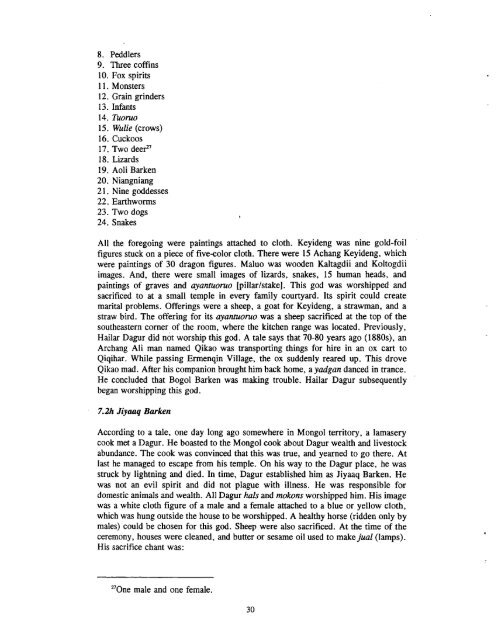China's Dagur Minority - Sino-Platonic Papers
China's Dagur Minority - Sino-Platonic Papers
China's Dagur Minority - Sino-Platonic Papers
You also want an ePaper? Increase the reach of your titles
YUMPU automatically turns print PDFs into web optimized ePapers that Google loves.
8. Peddlers9. Three coffins10. Fox spirits1 1. Monsters12. Grain grinders13. Infants14. Tuoruo15. Wulie (crows)16. Cuckoos17. Two deep18. Lizards19. Aoli Barken20. Niangniang2 1. Nine goddesses22. Earthworms23. Two dogs24. SnakesAll the foregoing were paintings attached to cloth. Keyideng was nine gold-foilfigures stuck on a piece of fivecolor cloth. There were 15 Achang Keyideng, whichwere paintings of 30 dragon figures. Maluo was wooden Kaltagdii and Koltogdiiimages. And, there were small images of lizards, snakes, 15 human heads, andpaintings of graves and ayan&oruo [pillar/stake]. This god was worshipped andsacrificed to at a small temple in every family courtyard. Its spirit could createmarital problems. Offerings were a sheep, a goat for Keyideng, a strawman, and astraw bird. The offering for its ayantuoruo was a sheep sacrificed at the top of thesoutheastern corner of the room, where the kitchen range was located. Previously,Hailar <strong>Dagur</strong> did not worship this god. A tale says that 70-80 years ago (1880s), anArchang Ali man named Qikao was transporting things for hire in an ox cart toQiqihar. While passing Ermenqin Village, the ox suddenly reared up. This droveQikao mad. After his companion brought him back home, a yadgan danced in trance.He concluded that Bogol Barken was making trouble. Hailar <strong>Dagur</strong> subsequentlybegan worshipping this god.'According to a tale, one day long ago somewhere in Mongol territory, a lamaserycook met a <strong>Dagur</strong>. He boasted to the Mongol cook about <strong>Dagur</strong> wealth and livestockabundance. The cook was convinced that this was true, and yearned to go there. Atlast he managed to escape from his temple. On his way to the <strong>Dagur</strong> place, he wasstruck by lightning and died. In time, <strong>Dagur</strong> established him as Jiyaaq Barken. Hewas not an evil spirit and did not plague with illness. He was responsible fordomestic animals and wealth. All <strong>Dagur</strong> hals and mokons worshipped him. His imagewas a white cloth figure of a male and a female attached to a blue or yellow cloth,which was hung outside the house to be worshipped. A healthy horse (ridden only bymales) could be chosen for this god. Sheep were also sacrificed. At the time of theceremony, houses were cleaned, and butter or sesame oil used to make jual (lamps).His sacrifice chant was:male and one female.30
















